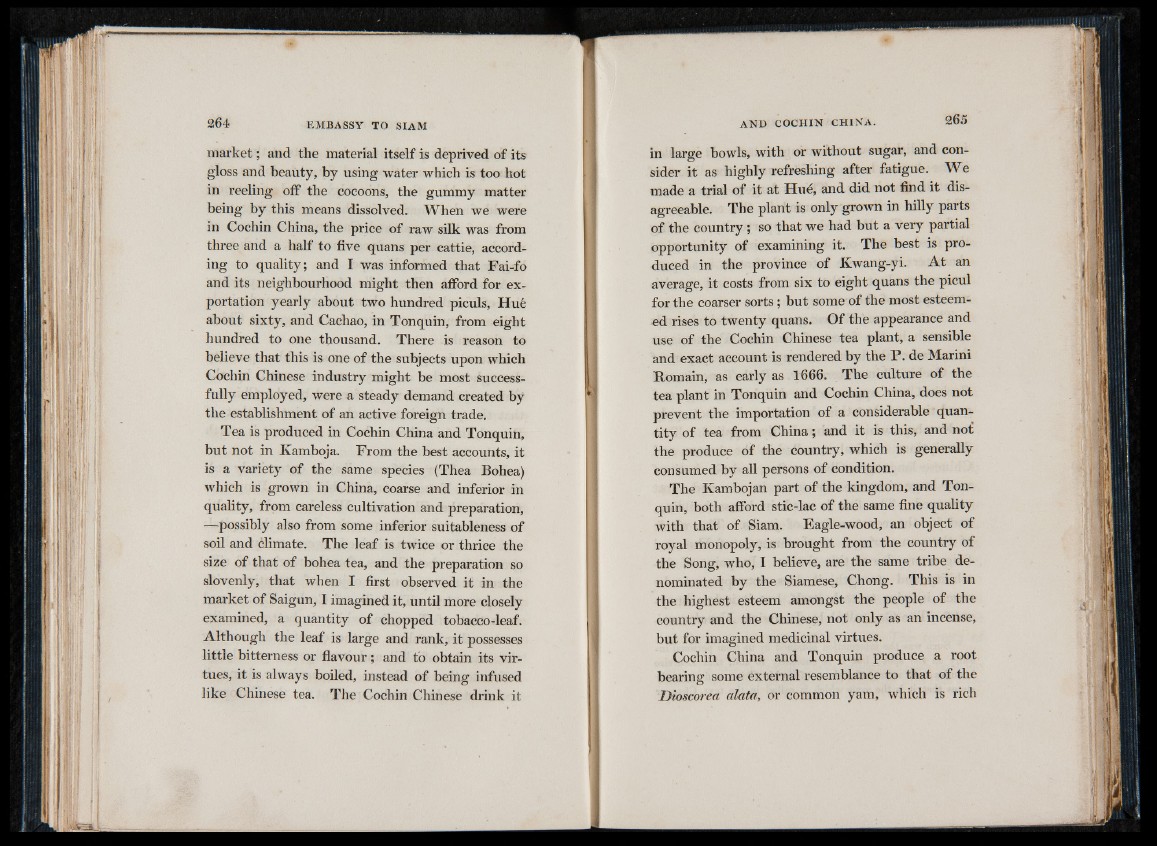
market ; and the material itself is deprived of its
gloss and beauty, by using water which is too hot
in reeling off the cocoons, the gummy matter
being by this means dissolved. WEen we were
in Cochin China, the price of raw silk was from
three and a half to five quans per cattie, according
to quality; and I was informed that Fai-fo
and its neighbourhood might then afford for exportation
yearly about two hundred piculs, Hué
about sixty, and Cachao, in Tonquin, from eight
hundred to one thousand. There is reason to
believe that this is one of the subjects upon which
Cochin Chinese industry might be most successfully
employed, were a steady demand created by
the establishment of an active foreign trade.
Tea is produced in Cochin China and Tonquin,
but not in Kamboja. From the best accounts, it
is a variety of the same species (Thea Bohea)
which is grown in China, coarse and inferior in
quality, from careless cultivation and preparation,
—possibly also from some inferior suitableness of
soil and climate. The leaf is twice or thrice the
size of that of bohea tea, and the preparation so
slovenly, that when I first observed it in the
market of Saigun, I imagined it, until more closely
examined, a quantity of chopped tobacco-leaf.
Although the leaf is large and rank, it possesses
little bitterness or flavour ; and to obtain its virtues,
it is always boiled, instead of being infused
like Chinese tea. The Cochin Chinese drink it
in large bowls, with or without sugar, and consider
it as highly refreshing after fatigue. We
made a trial of it at Hué, and did not find it disagreeable.
The plant is only grown in hilly parts
of the country ; so that we had but a very partial
opportunity of examining it. The best is produced
in the province of Kwang-yi. A t an
average, it costs from six to eight quans the picul
for the coarser sorts ; but some of the most esteemed
rises to twenty quans. Of the appearance and
use of the Cochin Chinese tea plant, a sensible
and exact account is rendered by the P. de Marini
Romain, as early as 1666. The culture of the
tea plant in Tonquin and Cochin China, does not
prevent the importation of a considerable quantity
of tea from China ; and it is this, and not
the produce of the country, which is generally
consumed by all persons of condition.
The Kambojan part of the kingdom, and Tonquin,
both afford stic-lac of the same fine quality
with that of Siam. Eagle-wood, an object of
royal monopoly, is brought from the country of
the Song, who, I believe, are the same tribe denominated
by the Siamese, Chong. This is in
the highest esteem amongst the people of the
country and the Chinese, not only as an incense,
but for imagined medicinal virtues.
Cochin China and Tonquin produce a root
bearing some external resemblance to that of the
Dioscorea alata, or common yam, which is rich